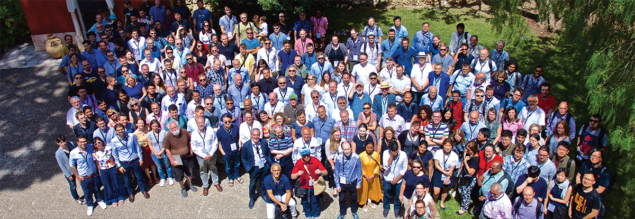
The XVIII International Conference on Strangeness in Quark Matter (SQM 2019) was held from 10 to 15 June in Bari, Italy. With 270 delegates from 32 countries, the largest participation ever for the SQM series, the conference focused on the role of strange and heavy-flavour quarks in heavy-ion collisions and astrophysics. The scientific programme consisted of 50 invited plenary talks, 76 contributed parallel talks and a rich poster session with more than 60 contributions.
A state-of-the-art session opened the conference, also including a tribute to the late Roy Glauber entitled “The Glauber model in high-energy nucleus–nucleus collisions”. Subsequent sessions were dedicated to highlights from theory and experiment, and included reports on results from low- and high-energy collisions, as well as on hyperon interactions in lattice QCD and thermal models. Representatives from all major collaborations at CERN’s LHC and SPS, Brookhaven’s RHIC, the Heavy Ion Synchrotron SIS at the GSI Darmstadt and the NICA project at the JINR Dubna made special efforts to release new results at SQM 2019.
Among the highlights were reports that particle-yield measurements are close to determining where phenomena such as strangeness enhancement are localised in phase space. Collective behaviour in small systems was also a much-discussed topic, with new results from the PHENIX experiment showing that p-Au, d-Au and 3He-Au collisions exhibit elliptic flow coefficients consistent with expectations regarding their initial collision geometry. Results from ALICE, CMS and STAR consistently corroborate the presence of elliptic flow in small systems.
There is also increasing interest in transverse-momentum differential baryon-to-meson ratios in the heavy-flavour sector. Recent results from pp and Pb-Pb collisions from both ALICE and CMS suggest that the same dynamics observed in the ratio Λ/K0S may be present in Λc/D, despite the fact that strange and charm quarks are thought to be created in different stages of the system’s evolution. Further studies and future measurements may be needed.
A promising new perspective for the LHC data is to use high-energy pp and p-Pb collisions as factories of identified hadrons created by a source of finite radius and then to measure the ensuing interactions between these hadrons using femtoscopy. This technique has allowed the ALICE collaboration to study interactions that were so far not measured at all and probe, for instance, the p-Ξ and p-Ω interaction potentials. These results provide fundamental constraints to the QCD community and are significant in the context of the astrophysics.
New results on the onset of deconfinement were shown by the NA61/SHINE collaboration. First results on strangeness production at low energy from HADES and BM@N also enriched the discussion at SQM 2019.
Presentations at the final session showed good prospects for future measurements at FAIR (GSI Darmstadt), NICA (JINR Dubna), the Heavy-Ion Project (J-PARC), and at CERN, given ongoing detector upgrades, the high-luminosity programme, and possible next-generation colliders. Perspectives for QCD measurements at future electron–ion colliders were also presented. On the theory side, new developments and strong research efforts are bringing a better understanding of strangeness production and open heavy-flavour dynamics in heavy-ion collisions.
Young scientist prizes sponsored by the Nuclear Physics European Collaboration Committee were awarded to Bong-Hwi Lim of Pusan National University, Korea, and to Olga Soloveva of Goethe University, Frankfurt for their poster contributions. The inaugural Andre Mischke Award (established at SQM2019) for the young scientist with the best experimental parallel talk was given to Erin Frances Gauger of the University of Texas, Austin.
The next edition of SQM will take place in Busan, Korea, in May 2021.








